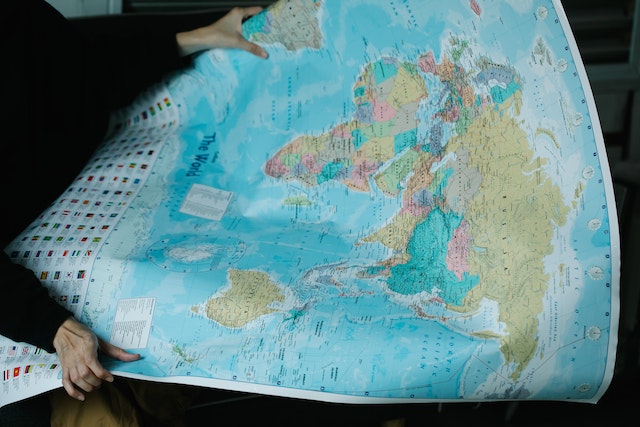No one can deny the power of maps in our daily navigation. Thanks to their visual representation of geographical locations, they have become essential in how we commute and understand our world. Even more impressive is the ability to plot points on a map when planning a road trip.
In this guide, we will explore the significance of including points on a map and what they entail. We’ll also discuss the step-by-step process of plotting them accurately. To begin with, let’s consider their importance in our everyday life.

- Understanding Points on a Map: Its Importance in Navigation
- What Are Point Symbols on a Map and Their Different Types?
- How To Plot Latitude and Longitude Accurately
- 7 Straightforward Steps on How To Plot Points on a Map
- 1. Select the Map You Want To Employ To Plot Points on a Map
- 2. Obtain the Coordinates of the Location You Want To Mark
- 3. Plot Multiple Locations on the Map Using Geographic Coordinates
- 4. Double-Check Your Coordinates and Label Points on a Map
- 5. Enhance Visualization When You Plot Points on a Map
- 6. Include a Map Legend
- 7. Interpret and Analyze the Points on a Map
- Mapize Is the Right Platform to Map Multiple Points
Understanding Points on a Map: Its Importance in Navigation
Points on a map are simple markers that represent specific locations and serve various purposes on a map. While they are simple, they hold great importance as they guide us through uncharted territories and reveal the wonders of our planet.
Of course, knowing the points can help you skillfully employ them as you explore and discover new places on earth. Without further ado, let’s consider their importance in our daily lives.
1. Points on a Map Help Us Navigate With Precision
Points on a map are crucial for navigation, as they provide precise coordinates that help us stay on the right course. By plotting these points and connecting them, we can navigate efficiently. For instance, if we are looking to map multi-stop routes, these markers can help us stay on track and reach our desired destination.

2. Points on a Map Aid the Discovery of New Horizons
Beyond familiar boundaries, points on a map can help you explore unknown destinations. From remote islands to bustling cities or perhaps discovering creepy earth locations, they enable us to embark on adventures that expand our horizons.
3. Points on a Map Are Important in Understanding Spatial Relationships
Points on a map enable us to comprehend spatial relationships between various points to understand our surroundings better. By visualizing the distribution of points, we can identify patterns or clusters in geographic data.
This knowledge of spatial relationships between points has become invaluable in various fields, including urban planning, real estate, and environmental conservation. Thus, workers in these fields can analyze and make informed decisions effectively.
4. Points on a Map Are Essential in Planning and Decision-Making
Points on a map are instrumental in planning and decision-making processes. They can assist you when you’re mapping multiple routes in your delivery business by providing accurate spatial context. They help us consider factors, evaluate trade-offs, and make informed decisions that optimize outcomes.
The importance of points on a map is impressive, and they continue to provide the ultimate guidance as we navigate our world. Is there any significance of point symbols on a map? Please pay attention to the next section.

What Are Point Symbols on a Map and Their Different Types?
Maps are not merely static images but visual aids that communicate information about our world. To aid our understanding, we must also recognize what point symbols are on a map. Point symbols on a map are small icons that represent various features or points on a map. They allow us to identify and differentiate a point on the map from another, thus condensing complex information into concise and recognizable icons.
During navigation, these points symbols highlight significant landmarks and important points of interest. As such, they enable map readers to prioritize and focus on such points. Different symbols represent a point on a map. Let’s consider the types of point symbols we use on maps today:
- Iconic Symbols: These symbols are simplified visual representations of objects, such as trees, buildings, mountains, or bodies of water. They capture the essence of the feature concisely and recognizably.
- Geometric Symbols: Geometric shapes, such as circles, squares, triangles, or crosses, often serve as point symbols. These symbols can be filled or outlined, with variations in size or color to convey additional information.
- Pictorial Symbols: Pictorial symbols depict features using more detailed and realistic illustrations. They usually serve as graphical representations of landmarks, tourist attractions, or cultural icons. As a result, they provide a visually appealing representation that enhances map aesthetics.
- Color-Coded Symbols: Colors convey specific meanings or attributes associated with the points. For example, green may represent parks or natural areas. Blue may represent bodies of water, and red may indicate emergency services or warning locations.
Points symbols are integral in our understanding of points on a map. They assist us in navigating and understanding our world better. So whenever you explore a map, pay close attention to them.

How To Plot Latitude and Longitude Accurately
As we’ll see in the next section of this guide, learning how to plot latitude and longitude is an important step when plotting points on a map. Latitude (also known as parallels) runs horizontally, encircling the Earth parallel to the Equator. The Equator represents 0 degrees latitude, with lines extending towards the North Pole (0 to 90 degrees) and the South Pole (0 to -90 degrees).
On the other hand, longitude (also known as meridians) runs vertically from the North Pole to the South Pole. The Prime Meridian, located in Greenwich, London, is the starting point, with lines extending eastward (0 to 180 degrees) and westward (0 to -180 degrees).
Plotting the latitude and longitude of a point on a map includes the following easy processes:
- Locate the Prime Meridian (0 degrees longitude) and the Equator (0 degrees latitude). These two reference points serve as the foundation for plotting other coordinates.
- Plot the longitude by finding the appropriate vertical line on the map corresponding to the given longitude coordinate. Measure from the Prime meridian, eastward (positive values) or westward (negative values).
- Plot the latitude by locating the horizontal line on the map that corresponds to the given latitude coordinate. Measure from the Equator, northward (positive values) or Southward (negative values).
- Mark the point where the line of latitude intersects the line of longitude.

7 Straightforward Steps on How To Plot Points on a Map
Undoubtedly, you are getting better at understanding and locating map points. Besides finding them, you can also learn how to plot points on a map. Here are the simple steps to do so effectively.
1. Select the Map You Want To Employ To Plot Points on a Map
The first step to plotting points on a map is to choose a map that suits your purpose. You can use a printed map or an online map service like Google Maps or OpenStreetMap. Regardless of your choice, ensure the map provides the detail necessary for plotting points accurately.
2. Obtain the Coordinates of the Location You Want To Mark
The next step in plotting points on a map is using the correct geographic coordinates (latitude and longitude) of the location you wish to mark. Asides from the steps we discussed previously in this article, here are other ways to obtain latitude and longitude coordinates:
- GPS Devices: You can use a GPS device or smartphone app to obtain latitude and longitude coordinates directly from your current location or specific point of interest.
- Geocoding Services: If you have addresses or their names, you can employ online geocoding services, which convert them to latitude and longitude coordinates.
- Online Database: these are official records governments and organizations use to access latitude and longitude coordinates for landmarks, cities, or specific points of interest.

3. Plot Multiple Locations on the Map Using Geographic Coordinates
Once you have established the location of a point via its geographic coordinates, you can also plot multiple locations if you intend to plot many points on a map. Remember to be careful in this step to avoid plotting errors.
4. Double-Check Your Coordinates and Label Points on a Map
The next step to consider when plotting points on a map is to ensure their accuracy. You can do this by double-checking the latitude and longitude values. Make any necessary adjustments if you find any errors. Once you’ve ensured precision and accuracy, label each point with appropriate identifiers or names to provide context and reference.
5. Enhance Visualization When You Plot Points on a Map
When plotting points, it is vital to enhance their visualization. This is necessary as they can provide additional information to the target audience, making the map more informative and visually appealing. To do so, consider using different symbols, colors, or sizes to represent various categories or attributes associated with the points on a map.
6. Include a Map Legend
After the visualization process, the next step in plotting points on a map is to include a map legend. It explains the meaning of the symbols and colors you used for the plotted points. It will help map readers understand the representation and significance of the points. Also, provide necessary information about the map, such as the title and scale.
7. Interpret and Analyze the Points on a Map
After plotting points on a map, the final step is interpreting and analyzing the emerging spatial relationships, patterns, or insights. Identify clusters and analyze distribution patterns to gain a deeper understanding of the data that you mapped.
Mapize Is the Right Platform to Map Multiple Points
Remarkably, points on a map emerge as vital coordinates that allow us to explore and navigate the wonders of our world. They reveal the intricate tapestry of our planet and provide helpful information about places and locations beyond our imagination.
While we must recognize the importance of points on a map, we have platforms like Mapize that enhance our mapping experiences. Mapize empowers users to plot and visualize points seamlessly while transforming static maps into dynamic and interactive ones.
With its user-friendly interface and robust features, Mapize enables users to collaborate, customize and share maps easily. Furthermore, Mapize enables easy navigation and analysis of spatial patterns, which ultimately culminates in making informed decisions. Whether planning a memorable journey, conducting research, or coordinating resources, Mapize can amplify your mapping capabilities and impact. Try Mapize today and create your custom maps with ease.





